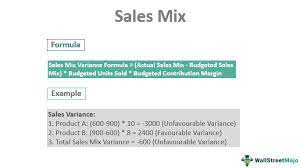Are How To Calculate Sales Mix you looking to boost your business’s profitability and drive sales growth? Then understanding your sales mix is crucial! Calculating your sales mix can help you identify which of your products or services are the most profitable, allowing you to make informed decisions about pricing, promotions, and inventory management. In this blog post, we’ll guide you through the steps necessary to calculate your sales mix so that you can optimize profitability and achieve business success. So let’s dive in!
What is a Sales Mix?
A sales mix is the combination of product, price, and promotion used to sell a product or service. The three factors are determined by what makes the most money for your business.
The three main sales mix categories are:
1. Product-based sales mix: This type of sale is when a company sells products that it produces itself. It may use different prices and promotional methods depending on how much profit it wants to make.
2. Service-based sales mix: This type of sale is when a company sells services instead of products. It may use different prices and promotional methods depending on how much profit it wants to make.
3. Price-based sales mix: This type of sale uses different prices to attract customers to buy a product or service.
How to Calculate Your Sales Mix
Sales mix is a critical piece of business analysis and is used to understand how sales are generated and divided among different channels. There are four major components to your sales mix: product, price, place, and promotion.
To calculate your sales mix, you first need to know the value of each type of sale. The value of a sale is based on the amount of money the customer paid for the product and any associated taxes. To find the value of a sale, divide total revenue by unit sales.
Next, you need to determine how much each channel contributes to your total sales. Each channel generates a different percentage of your total sales. Product sales account for the majority of your revenue, with price and place contributing just over 20 percent each. Promotion makes up the smallest percentage with just over 5 percent contribution.
The final step in calculating your sales mix is to combine these percentages into a single number that reflects how much each channel contributes to overall revenue. This number is called your gross margin percentage. Your gross margin percentage tells you how profitable your business is overall using this specific set of data.
Tips for Improving Your Sales Mix
1. Calculate Your Sales Mix
One of the most important things you can do to improve your sales mix is to calculate it. To do this, you need to know what percentage of your revenue comes from each type of sale.
For example, if your business generates $100,000 in revenue each month, you would divide that figure by 12 to get your monthly sales numbers. Then, you would subtract any expenses (such as salaries and marketing costs) from that number to get your net profits. From there, you could allocate a specific percentage of net profits to each type of sale.
2. Focus on High-Growth Markets
The best way to boost your sales mix is to focus on high-growth markets. This means targeting markets that are growing quickly and have a lot of potential for growth. This can be tricky, but it’s definitely worth it if you want to see great results in terms of increased revenue and total market share.
3. Pursue Repeat Customers
Another key element of boosting your sales mix is pursuing repeat customers. This means working hard not only to attract new customers during the initial phase of their relationship with your business, but also ensuring that those customers stay with you long term. Doing so will help ensure that you maintain a healthy balance between new and returning customers, which is essential for sustained growth in any industry or market sector.
Conclusion
In this article, we have walked you through the steps of calculating your sales mix. By doing so, you can better understand which products and services are bringing in the most revenue for your business. Armed with this knowledge, you can make informed decisions about how to allocate resources and focus your marketing efforts on those items that are most effective. Thank you for reading!











